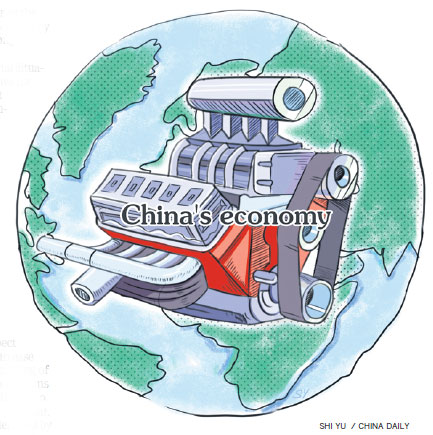Growth shows China's economy has resilience

Still driving global growth
China's GDP achieved a 6.9 percent growth year-on-year based on comparable prices in the first quarter of this year. From the perspective of the world economic pattern, this is an economic performance beyond extensive market expectations and its biggest effect will be to further consolidate China's status as the world's economic stabilizer and engine. Many market analysts previously anticipated that China would maintain such a status for the foreseeable future, but the first-quarter performance will further enhance their confidence in the Chinese economy.
For China's trading partners and the world economy, promoting the interaction between China's economic growth and its wider opening-up, and between China's economic growth and its expanding imports offer a good opportunity for them to take a free ride on the fast-driving Chinese train.
In the first quarter of this year, China's imports grew by 31.1 percent year-on-year, 16.3 percentage points higher than its growth in exports, which was 14.8 percent. Despite its continuous domestic crude oil consumption growth, China's crude oil output has been on a downward trajectory since last year, with the output declining by 6.8 percent year-on-year in the first quarter, 5.0 percentage points higher than last year's decline. This is enough to demonstrate that at a time of bearish international oil prices, China has not chosen to protect domestic oil manufacturers, but instead chosen to substitute expanded imports for domestic manufacturing, a move that has brought it under increased pressure from industrial transformation and labor transfer. Such a choice shows that China is a responsible trading power.
Mei Xinyu, a research fellow with Chinese Academy of International Trade and Economic Cooperation under the Ministry of Commerce
Economy has strong momentum
With its booming real estate market, China's economy grew by 6.9 percent year-on-year in the first quarter, a slight increase from 6.8 percent in the fourth quarter of last year. Multiple economic indexes show that China's economy has strong momentum. Based on its comprehensive analyses of various factors, Deutsche Bank has raised its previous 2017 forecast of China's GDP growth from 6.5 percent to 6.7 percent and also raised its 2018 expectation to 6.3 percent. Deutsche Bank also expects that, due to its slowed credit growth, China's GDP growth may moderately slow in the following three quarters to 6.8 percent, 6.6 percent and 6.5 percent respectively.
Considering that currently China does not face the urgent demand to launch a new round of fiscal stimulus packages, Deutsche Bank believes that the country is unlikely to raise its benchmark interest rates this year, but the possibility for interest rate rises will rise in 2018.
Zhiwei Zhang, an economist with Deutsche Bank
Time to reign in credit growth
China's GDP growth picked up further to 6.9 percent year-on-year in the first quarter as the industrial sector was boosted by better exports and strong real estate activity.
We expect the external situation to remain conducive for the rest of 2017. Recent indicators show continued improvement in the global demand momentum. While downside risks remain, we think the risk of drastic trade tension with the United States has declined after the recent meeting between President Xi Jinping and US President Donald Trump. In all the prospects for exports are reasonable.
Nonetheless, we expect domestic momentum to ease later in 2017 as the tightening of housing purchasing restrictions in many large cities will start to weigh on real estate investment. More generally, as underlined by the recent rise in short term interest rates, the macro policy stance will this year be somewhat less accommodative than in 2016.
Looking ahead, we estimate that the overall credit growth target for this year is 14.8 percent, a modest slowdown from 16.1 percent in 2016. With nominal GDP growth picking up, the addition to the credit-to-GDP ratio should moderate, from 15 percentage points in 2016 to 9.4 percentage points this year. But, on current trends, China is still far away from stabilizing the credit-to-GDP ratio. The big question going forward is when the leadership will start to move towards significantly reining in credit growth, accepting a slowdown in GDP growth that is necessary to put the growth trajectory on a more sustainable footing.
Louis Kuijs, head of Asia economics for Oxford Economics
Reaction to China GDP data
Optimism over the underlying growth momentum of the Chinese economy in 2017 has continued to improve, following official figures showing that GDP output grew by 6.9 percent over the first quarter of 2017. This represents stronger growth than was expected and does point towards the Chinese economy making a turnaround after consecutive years of declining growth. What has been impressive about the rebound has been the ongoing signs of domestic economic strength, and by this I mean consistency in domestic consumption with retail sales and a recent trade balance release being just a few pieces of economic data that has surprised to the upside.
Jameel Ahmad, VP of Corporate Development and Market Research at FXTM


















